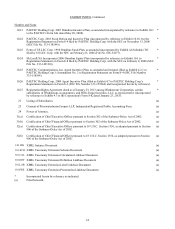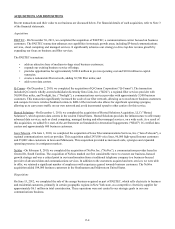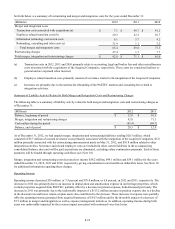Windstream 2012 Annual Report Download - page 104
Download and view the complete annual report
Please find page 104 of the 2012 Windstream annual report below. You can navigate through the pages in the report by either clicking on the pages listed below, or by using the keyword search tool below to find specific information within the annual report.
F-6
these changes is considered to be the revenues and expenses recognized during the period of each year for which
results from the acquired operations are not included in the comparative period of the prior year.
(b) Certain prior year amounts have been reclassified to conform to the current year financial statement presentation.
These reclassifications did not impact net or comprehensive income. Please see Note 2 for additional information.
(c) Total customers include each individual business customer location to which we provide service and exclude carrier
special access circuits.
Business Service Revenues
Business service revenues include revenues from integrated voice and data services, advanced data and traditional voice and
long-distance services to enterprise and small-business customers. Revenues from other carriers for special access circuits and
fiber connections are also included. We expect business service revenues to be favorably impacted by increasing demand for
data services such as integrated data and voice services, multi-site networking and data center services. As wireless data usage
grows and fourth generation ("4G") networks are expanded, we expect to provide special access services to support the
capacity needs of wireless carriers.
We experience competition in the business channel primarily from other carriers, including traditional telephone companies and
competitive providers. Cable television companies are also a source of competition, primarily for small business customers, but
have communicated their intention to compete for larger customers by expanding their product and sales capabilities.
For the twelve months ended December 31, 2012, business customers decreased by approximately 24,700 or 3.7 percent. Our
growth in enterprise customers is outpaced by losses in small business customers, typically due to competition from cable
companies. However, our enterprise customers are driving growth in overall revenue through purchases of integrated voice and
data services, data center and managed services, and advanced data services such as multi-site networking.
Despite the opportunities for growth from business services, competition and weakness in the economy may have the effect of
suppressing revenue growth. In addition, business voice and long-distance service revenues continue to decline due to
competition and migration to more advanced integrated voice and data services.
The following table reflects the primary drivers of year-over-year changes in business service revenues:
Twelve Months Ended
December 31, 2012
Twelve Months Ended
December 31, 2011
(Millions)
Increase
(Decrease) %
Increase
(Decrease) %
Due to acquired companies $ 1,446.0 $ 468.7
Due to changes in data and integrated services revenues (a) 49.6 54.9
Due to increases in carrier revenues (b) 17.9 46.0
Due to increases in data center and managed service revenues (c) 13.1 2.2
Due to increases in high-speed Internet revenues 3.0 (0.2)
Due to decreases in voice, long distance and miscellaneous
revenues (d) (16.2) (51.1)
Total changes in business revenues $ 1,513.4 72% $ 520.5 33%
(a) Increases in data and integrated services revenues were primarily due to demand for advanced data services and
customer migration to our integrated voice and data services, previously discussed.
(b) Increases in carrier revenues, which primarily represent monthly recurring charges for dedicated circuits, were
attributable to demand from wireless and other carriers, previously discussed.
(c) Increases in data center and managed service revenues, which includes monitoring, maintenance and support services for
business customers, is due to increased demand and incremental sales. We opened new data centers, as well as expanded
existing data centers, during 2012 to support this increase in demand.
























